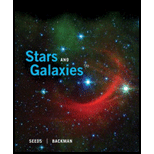
Stars and Galaxies
9th Edition
ISBN: 9781305120785
Author: Michael A. Seeds, Dana Backman
Publisher: Cengage Learning
expand_more
expand_more
format_list_bulleted
Question
Chapter 4, Problem 5RQ
To determine
The reason why Plato proposed that heavenly motion are uniform and circular.
Expert Solution & Answer
Want to see the full answer?
Check out a sample textbook solution
Students have asked these similar questions
He was the one who modified the idea of Aristotle who thought that the Earth was the center of the Universe.
Which of the following was used by Aristotle to prove the shape of the Earth?Which of the following refers to the science of studying the outer space and other celestial objects?Which of the following refers to the sun-centered model of the universe?Which of the following refers to the earth-centered model of the universe?Which of the following Astronomer was sentenced to death by church because of his opposing views and theories about the center of the universe?Which of the following was proposed by Ptolemy to fix the anomalies inAristotelian model of the universe?Which of the following models of the universe where the celestial planets revolve around the sun while the sun revolves around the earth?Which of the following Astronomers observed that Mars does not move incircles?Which of the following refers to the term where other celestial bodies/objects moves around the earth in a spherical manner?Which of the following terms refer to the part Pythagorean universe where the Greek Gods…
How did the Greek’s view the Universe during their time?
Chapter 4 Solutions
Stars and Galaxies
Ch. 4 - Prob. 1RQCh. 4 - Prob. 2RQCh. 4 - Prob. 3RQCh. 4 - Prob. 4RQCh. 4 - Prob. 5RQCh. 4 - Prob. 6RQCh. 4 - Which two-dimensional (2D) and three-dimensional...Ch. 4 - Prob. 8RQCh. 4 - Prob. 9RQCh. 4 - Prob. 11RQ
Ch. 4 - Prob. 12RQCh. 4 - Prob. 13RQCh. 4 - Prob. 14RQCh. 4 - Prob. 16RQCh. 4 - Prob. 17RQCh. 4 - Prob. 18RQCh. 4 - Prob. 19RQCh. 4 - Prob. 20RQCh. 4 - Prob. 21RQCh. 4 - Prob. 22RQCh. 4 - How did the Alfonsine Tables, the Prutenic Tables,...Ch. 4 - Prob. 24RQCh. 4 - Prob. 25RQCh. 4 - Prob. 26RQCh. 4 - Prob. 27RQCh. 4 - Draw and label a diagram of the western horizon...Ch. 4 - Prob. 2PCh. 4 - Prob. 3PCh. 4 - Prob. 4PCh. 4 - Prob. 5PCh. 4 - Prob. 6PCh. 4 - One planet is three times farther from the Sun...Ch. 4 - Prob. 9PCh. 4 - Prob. 10PCh. 4 - Prob. 11PCh. 4 - Prob. 1LLCh. 4 - Prob. 2LLCh. 4 - What three astronomical objects are represented...Ch. 4 - Prob. 4LL
Knowledge Booster
Learn more about
Need a deep-dive on the concept behind this application? Look no further. Learn more about this topic, physics and related others by exploring similar questions and additional content below.Similar questions
- How did Hipparchus discover the wobble of Earth’s axis, known as precession?arrow_forwarddiscuss some of the cultural and philosophical implications related to the geocentric modelarrow_forwardAncient astronomers believed that the sun, moon, stars, and planets were tied to a revolving what to explain the daily and annual movements of the heavens?arrow_forward
- How would Eratosthenes’s estimate have been different if the sun were actually closer to Earth?arrow_forwardThe average Earth-Moon distance is 3.84 X 10^5 km, while the Earth-Sun is 1.496 X 10^8 km. Since the radius of the Moon is 1.74 X 10^3 km and that of the Sun is 6.96 X 10^5 km. a) Calculate the angular radius of the Moon and the Sun, qmax, according to the following figure. D Bax R b) Calculate the solid angle of the Moon and the Sun as seen from Earth. (c) Interpret its results; Would this be enough to explain the occurrence of total solar eclipses?arrow_forwardPlease give me the complete concept of this question. I also gave choices to help get the answer:arrow_forward
- Please give me the complete concept of this question. I also gave choices to help get the answer:arrow_forwardGive proper explanationarrow_forwardSuppose, we recently discovered a new planet named Concordia. If for 15 degrees difference, the distance between Cansae City and and Cantabrigia City would have been 6050 stadia. According to Erasthosthenes' calculation, what would have been the circumference of Concordia? 5.45E5 stadia 2.45E5 stadia 4.45E5 stadia 1.45E5 stadia 3.45E5 stadiaarrow_forward
arrow_back_ios
SEE MORE QUESTIONS
arrow_forward_ios
Recommended textbooks for you
 Stars and Galaxies (MindTap Course List)PhysicsISBN:9781337399944Author:Michael A. SeedsPublisher:Cengage Learning
Stars and Galaxies (MindTap Course List)PhysicsISBN:9781337399944Author:Michael A. SeedsPublisher:Cengage Learning
 Foundations of Astronomy (MindTap Course List)PhysicsISBN:9781337399920Author:Michael A. Seeds, Dana BackmanPublisher:Cengage Learning
Foundations of Astronomy (MindTap Course List)PhysicsISBN:9781337399920Author:Michael A. Seeds, Dana BackmanPublisher:Cengage Learning AstronomyPhysicsISBN:9781938168284Author:Andrew Fraknoi; David Morrison; Sidney C. WolffPublisher:OpenStax
AstronomyPhysicsISBN:9781938168284Author:Andrew Fraknoi; David Morrison; Sidney C. WolffPublisher:OpenStax An Introduction to Physical SciencePhysicsISBN:9781305079137Author:James Shipman, Jerry D. Wilson, Charles A. Higgins, Omar TorresPublisher:Cengage Learning
An Introduction to Physical SciencePhysicsISBN:9781305079137Author:James Shipman, Jerry D. Wilson, Charles A. Higgins, Omar TorresPublisher:Cengage Learning Stars and GalaxiesPhysicsISBN:9781305120785Author:Michael A. Seeds, Dana BackmanPublisher:Cengage Learning
Stars and GalaxiesPhysicsISBN:9781305120785Author:Michael A. Seeds, Dana BackmanPublisher:Cengage Learning

Stars and Galaxies (MindTap Course List)
Physics
ISBN:9781337399944
Author:Michael A. Seeds
Publisher:Cengage Learning


Foundations of Astronomy (MindTap Course List)
Physics
ISBN:9781337399920
Author:Michael A. Seeds, Dana Backman
Publisher:Cengage Learning

Astronomy
Physics
ISBN:9781938168284
Author:Andrew Fraknoi; David Morrison; Sidney C. Wolff
Publisher:OpenStax

An Introduction to Physical Science
Physics
ISBN:9781305079137
Author:James Shipman, Jerry D. Wilson, Charles A. Higgins, Omar Torres
Publisher:Cengage Learning

Stars and Galaxies
Physics
ISBN:9781305120785
Author:Michael A. Seeds, Dana Backman
Publisher:Cengage Learning
Time Dilation - Einstein's Theory Of Relativity Explained!; Author: Science ABC;https://www.youtube.com/watch?v=yuD34tEpRFw;License: Standard YouTube License, CC-BY